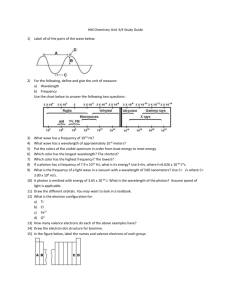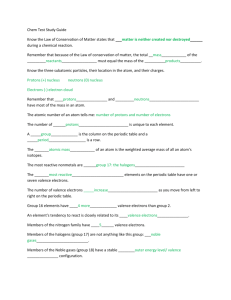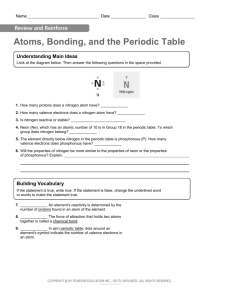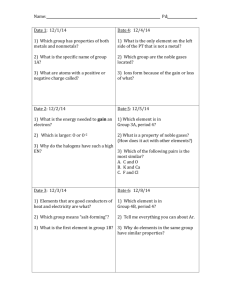Ch. 8 – Lewis Structures Packet – 2015-16
advertisement
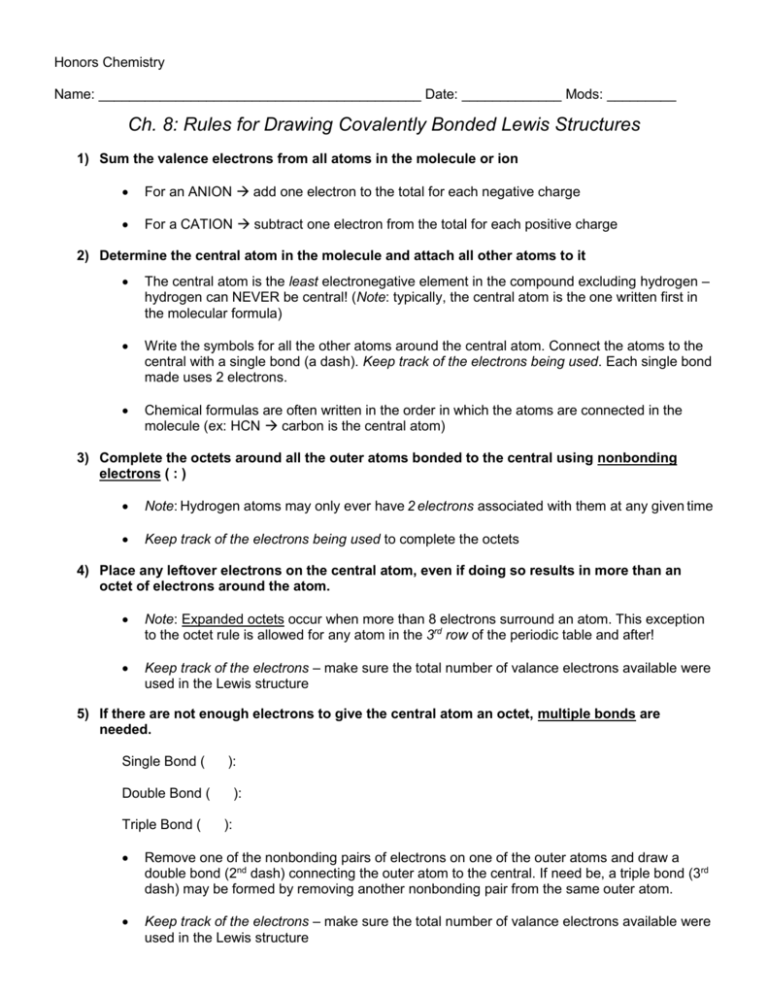
Honors Chemistry Name: __________________________________________ Date: _____________ Mods: _________ Ch. 8: Rules for Drawing Covalently Bonded Lewis Structures 1) Sum the valence electrons from all atoms in the molecule or ion For an ANION add one electron to the total for each negative charge For a CATION subtract one electron from the total for each positive charge 2) Determine the central atom in the molecule and attach all other atoms to it The central atom is the least electronegative element in the compound excluding hydrogen – hydrogen can NEVER be central! (Note: typically, the central atom is the one written first in the molecular formula) Write the symbols for all the other atoms around the central atom. Connect the atoms to the central with a single bond (a dash). Keep track of the electrons being used. Each single bond made uses 2 electrons. Chemical formulas are often written in the order in which the atoms are connected in the molecule (ex: HCN carbon is the central atom) 3) Complete the octets around all the outer atoms bonded to the central using nonbonding electrons ( : ) Note: Hydrogen atoms may only ever have 2 electrons associated with them at any given time Keep track of the electrons being used to complete the octets 4) Place any leftover electrons on the central atom, even if doing so results in more than an octet of electrons around the atom. Note: Expanded octets occur when more than 8 electrons surround an atom. This exception to the octet rule is allowed for any atom in the 3rd row of the periodic table and after! Keep track of the electrons – make sure the total number of valance electrons available were used in the Lewis structure 5) If there are not enough electrons to give the central atom an octet, multiple bonds are needed. Single Bond ( ): Double Bond ( Triple Bond ( ): ): Remove one of the nonbonding pairs of electrons on one of the outer atoms and draw a double bond (2nd dash) connecting the outer atom to the central. If need be, a triple bond (3rd dash) may be formed by removing another nonbonding pair from the same outer atom. Keep track of the electrons – make sure the total number of valance electrons available were used in the Lewis structure Drawing Covalent Lewis Structures – Examples Lewis Dot Structures: 1) Methane: CH4 4) Sulfite ion: SO32- 2) Hydrochloric Acid: HCl 5) Hydrocyanic Acid: HCN 3) Ammonia: NH3 6) Methanal (aka: formaldehyde): H2CO Resonance Structures: Multiple Lewis structures are used to describe molecules which have double or triples bonds that can be moved to different sides of the central atom and still stay bonded to an identical outer atom. 7) Nitrite ion: NO2 – Exceptions to the Octet Rule: Less than an Octet central atoms which have FEWER than 8 electrons (seen with B only) 8) BF3 Expanded Octet central atoms which have MORE than 8 electrons (this is allowed for central atoms found in the 3rd period and after) 9) SBr6 10) XeI4 Drawing Lewis Diagrams - Practice # of valence e-‘s:________ 1. SF4 3. PO43- 5. N2 2. CH2F2 # of valence e-‘s:________ # of valence e-‘s:________ 7. CO32- # of valence e-‘s:________ 4. CBr4 # of valence e-‘s:________ 6. CCl2O # of valence e-‘s:________ # of valence e-‘s:________ 8. ClO21– 10. H2S 12. NH4+ # of valence e-‘s:________ # of valence e-‘s:________ # of valence e-‘s:________ 11. C2H4 # of valence e-‘s:________ (attach carbons together – make symmetrical) # of valence e-‘s:________ 14. NO31- 9. OF2 13. BCl3 # of valence e-‘s:________ # of valence e-‘s:________ 15. IBr5 # of valence e-‘s:________ 17. C2H2 # of valence e-‘s:________ (attach carbons together – make symmetrical) 19. PCl3 # of valence e-‘s:________ 21. PF5 # of valence e-‘s:________ 16. SO42- # of valence e-‘s:________ 18. CO # of valence e-‘s:________ 20. SiO2 # of valence e-‘s:________ 22. PH3 # of valence e-‘s:________ 23. XeF4 # of valence e-‘s:________ 25. CN- # of valence e-‘s:________ 27. C2Br2 # of valence e-‘s:________ (attach carbons together – make symmetrical) 29. SeF4 # of valence e-‘s:________ 24. SeH2 # of valence e-‘s:________ 26. IF3 # of valence e-‘s:________ 28. ClO1– # of valence e-‘s:________ 30. AsF3 # of valence e-‘s:________



